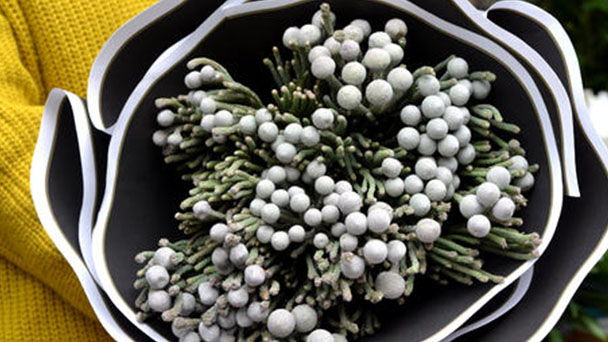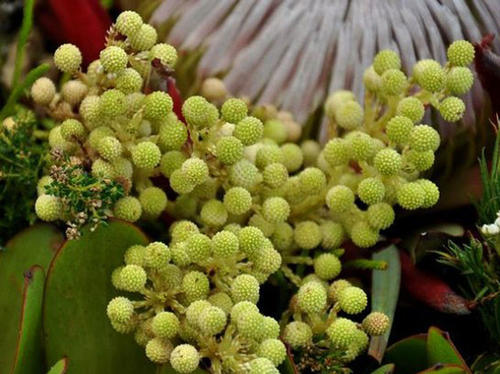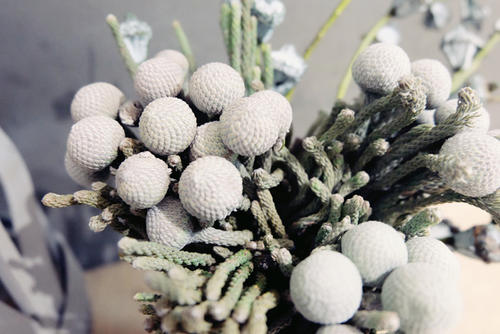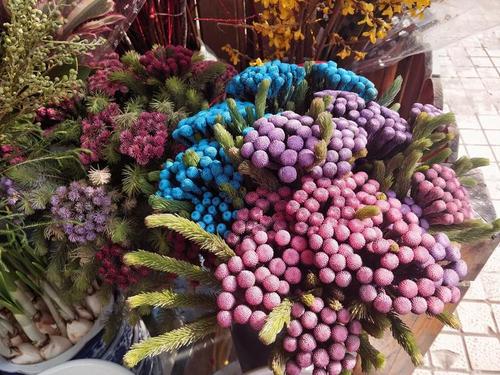Jerusalem cherry profile
Written by Maggie
Feb 20 2021

Jerusalem cherry, scientific name Solanum pseudocapsicum is a South African evergreen shrub of the genus Brunia in the family Acheraceae. Jerusalem cherry has erect erect stems, slender stems and needle-shaped leaves commonly found in silvery gray and green.
Flowers minute and dense, several head - shaped clusters into balls.
Jerusalem cherry picture

Jerusalem cherry morphological characteristics
Jerusalem cherry is an erect branching shrub, up to 2 m tall, glabrous throughout. Leaves are alternate, narrowly oblong to lanceolate, 1-6 cm long, 0.5-1.5 cm wide, apex acute or obtuse, base narrowly cuneate downward into petiole, margin entire or undulate, both surfaces smooth and glabrous, midvein protruding below, lateral veins 6-7 pairs, more pronounced below; Petiole of Jerusalem cherry ca. is 2-5 mm, indistinct from leaf blade.
Flowers of Jerusalem cherry are solitary, rarely caudate into cincinnati, absent or nearly absent pedicels, axillary extragalent or sub pairs of leaves, pedicels ca. 3-4 mm; Flowers are small, white, ca. 0.8 -- 1 cm in diameter; Calyx of Jerusalem cherry is green, ca. 4 mm in diam., 5-lobed, lobes ca. 1.5 mm long; Corolla tube concealed within calyx, less than 1 mm long, corolla eaves ca.5 mm long, lobes 5, ovate, ca. 3.5 mm long, ca. 2 mm wide; Filaments of Jerusalem cherry are less than 1 mm long, anthers yellow, moments rounded, ca. 2 mm long; Ovary is suborbicular, ca. 1 mm in diam., style short, ca. 2 mm long, stigma truncate. Berry of Jerusalem cherry is orange-red, 1-1.5 cm in diameter, calyx persistent, petiole ca. 1 cm long, apex swollen. Seeds of Jerusalem cherry are discoid, flattened, ca. 2-3 mm in diameter.Flowering in early summer, fruiting in late autumn.
Jerusalem cherry origin of habitat
Jerusalem cherry is native to South America; Jerusalem cherry is cultivated in Anhui, Jiangxi, Guangdong, Guangxi and North China. Some live along roadsides, along ditches and in open places. Jerusalem cherry likes warm, high temperature resistance, poor cold resistance.
Jerusalem cherry propagation methods
The Jerusalem cherry is usually propagated with seed, usually in the spring, and can be planted in all seasons in the tropics. Because each fruit may not mature at the same time, Jerusalem cherry should be picked as it ripens. The fruit is washed out of the seeds in water, dried and stored or immediately sown. Seeds of Jerusalem cherry can be first raised seedlings and then on the basin or direct seeding basin. The suitable temperature for seed germination is about 20-25°C, and it can be germinated in about 10 days. Jerusalem cherry needs to transplant, but when the seedlings have three to four true leaf before transplantation, in 7-8 true leaf again when the seedling planting in diameter is about more than 8 cm pot after (according to the size of the flowerpot and plant growth conditions to determine whether you need to change a bigger pot), or about 30 cm in diameter of the big flower pot, every kind of three strains. Do not transplant Jerusalem cherry during the period, from about 8 weeks after sowing seedlings directly into the pot.

How to grow and care for Jerusalem cherry
The basin soil
The Jerusalem Cherry is relatively coarse and does not require very strict soil, but it grows best in loam or sandy loam which is rich in organic matter, well drained, loose and fertile. If regular soil is used as a potting substrate, about a third of the organic matter rich material, such as peat, leaf rot, composting mushroom residue, Jerusalem cherry should be mixed into it.
Maintenance management
After sowing seedlings of Jerusalem cherry and planting on the pot, the heart can be picked once, and the heart can be picked to promote branching. The Jerusalem cherry shape is plump, the distribution is uniform, and the results are many. Generally, the seedlings sown in spring of the same year will blossom and bear fruit in summer. If you need to continue planting, you can remove the fruit after viewing, replace it with new soil, plant Jerusalem cherry in a larger pot, and it will bloom again in spring, and many times after that.If you wish to watch the fruit during the Spring Festival, you should leave all the flowers in autumn and remove all the flowers before. Jerusalem cherry in high temperature flowering, often poor pollination phenomenon, not easy to bear fruit, so the summer pot plant should be placed in the ventilated shade.
The Jerusalem Cherry prefers moist soil, which is less drought-tolerant, and avoids waterlogging and showers on hot summer days. Usually management to be a dry topsoil can be watered, winter low temperature can reduce the number of watering, air drying often to the foliar water. NPK compound fertilizer is applied to the pot once a month. Pay attention to the usual soil weeding work, do not let the basin water.
If you need to plant for many years or cultivate into large Jerusalem cherry, it can be in the spring of the fruit after the removal of the fruit, and then into a larger pot and new soil, and a pruning plastic, the last year long branches and leaves to cut about 2/3, then the subsequent issue of the new shoot again to pick the heart 1 times, in order to make the plant multiple branches. The Jerusalem Cherry, however, was not normally retained until the third year of production, but was resown.
Temperature and light
Temperature: in winter, it is best to put the pot Jerusalem cherry in a place above 5℃ to avoid falling fruit and extend the fruit viewing time. But in winter the temperature can not be higher than 16 degrees Celsius, but also to maintain high air humidity. If Jerusalem cherry is grown at home in northern China, the pot plant must be moved indoors in winter. But indoors, with heat, warmth and dry air, the fruit's lifespan is shortened. Therefore, put the Jerusalem cherry on a cushion or dish with wet pebbles, and spray the plant with water once a day.
Light: The Jerusalem Cherry works well in both full and half sunshine, but should be shaded in summer because the sun is too strong, especially at noon when the sun is most intense. However, if the environment of cultivation is too dark, the Jerusalem cherry is easy to grow barren, flower and bear poor fruit.
Jerusalem cherry main value
The Jerusalem Cherry is a traditional indoor potted fruit.Plants sown in spring bloom in summer and autumn, early autumn to spring fruit, New Year's Day and Spring Festival flowers in the off-season is a rare view of fruit flowers. Each fruit from the fruit to mature, and then to drop fruit, the time can be as long as 3 months, is potted fruit flowers in the fruit of the longest period of one of the varieties.
Medicines: The roots of the Jerusalem Cherry are used as medicine, pungent, slightly bitter, warm and toxic; Jerusalem cherry has the function of activating blood and relieving pain; The main treatment was lumbar muscle strain and flash sprain.
Jerusalem cherry flower language
Contentment, harvest and happiness.

Latest Updated
- Benefits of Bugleweed - 7 Science-backed Health Benefits
- Bugleweed Dangers & Side Effects - Is It Poisonous?
- How to Plant Evergreen Trees - What You Should Know
- When to Plant Evergreens - Grow Guide for Evergreen Trees
- 12 Wonderful Evergreen Shrubs for Your Garden
- 12 Popular Evergreen Plants with Pictures for Beginners
- When And How To Prune A Lilac Bush Like a Pro
- How to Grow & Care for Lilac Vine (Hardenbergia Violacea)
- Japanese Lilac Tree (Syringa Reticulata) Care & Propagation Guide
- Shumard Oak Pros and Cons - What to Know
Popular Articles
- Winter maintenance of Antirrhinum Majus
- How to Grow Terminalia Mantaly Tree
- How to Grow and Care for Crossostephium Chinense
- How to grow Antirrhinum Majus in spring
- Peristeria Elata (Dove Orchid) Profile: Info & Care Guide
- Underwatered Snake Plant (Sansevieria Trifasciata) - Signs And How To Fix
- How to Care for Brazilian Jasmine Plant (Mandevilla Sanderi)
- How to Grow & Care for Graptopetalum Purple Delight in Summer
- Rosa Chinensis (China Rose): Plant Growing & Care Tips
- How to Care for Baby Sun Rose (Aptenia Cordifolia)